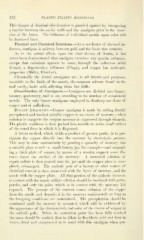Page 314 - My FlipBook
P. 314
312 PLASTIC FILLING MATERIALS.
This danger of dentinal discoloration is guarded against by interposing
a barrier between the cavity walls and the amalgam prior to the inser-
tion of the latter. The influence of individual metals upon color will
be discussed later.
Thermal and Chemical Relations.—As a conductor of thermal in-
fluence, amalgam is midway between gold and the basic zinc cements.
As to the actual effects upon the vital tissues of dentin, it has
never been demonstrated that amalgam exercises any specific influence,
except that cadmium appears to cause, through the cadmium sulfid
formed, a degenerative influence (Flagg), and copper has antiseptic
properties (Miller, Fletcher).
Chemically the dental amalgams are, to all intents and purposes,
insoluble in the fluids of the mouth, the common solvent found in the
oral cavity, lactic acid, affecting them but little.
Classification of Amalgams.—Amalgams are divided into binary,
ternary, quaternary, and so on, according to the number of constituent
metals. The only binary amalgams employed in dentistry are those of
copper and of palladium.
Binary Amalgams.—Copper amalgam is made by adding freshly
precipitated and washed metallic copper to an excess of mercury when
;
solution is complete the surplus mercury is expressed through chamois.
The plastic residuum is then packed into moulds to make small tablets
of the usual form in which it is dispensed.
A better method, which yields a product of greater purity, is to pre-
cipitate the copper directly into the mercury by electrolytic process.
This may be done conveniently by pouring a quantity of mercury into
a suitable glass vessel—a small battery jar, for example—and suspend-
ing a thick plate of copper, by means of a wooden support, some dis-
tance above the surface of the mercury. A saturated solution of
cupric sulfate is then poured into the jar until the copper plate is com-
pletely submerged. The cathode pole of a battery or other source of
electrical current is then connected with the layer of mercury, and the
anode with the copper plate. All that portion of the cathode electrode
in contact with the cupric sulfate solution should be insulated with gutta-
percha, and only the point which is in contact with the mercury left
exposed. The passage of the current causes solution of the copper
from the anode and deposits it in the mercury continuously as long as
the foregoing conditions are maintained. The precipitation should be
continued until the mercury is saturated, which will be evidenced by
the appearance of the characteristic red color of the excess of copper at
the cathode pole. When the saturation point has been fully reached
the mass should be washed, first in dilute hydrochloric acid and then in
water, dried and compressed as is usual with this amalgam when pre-


